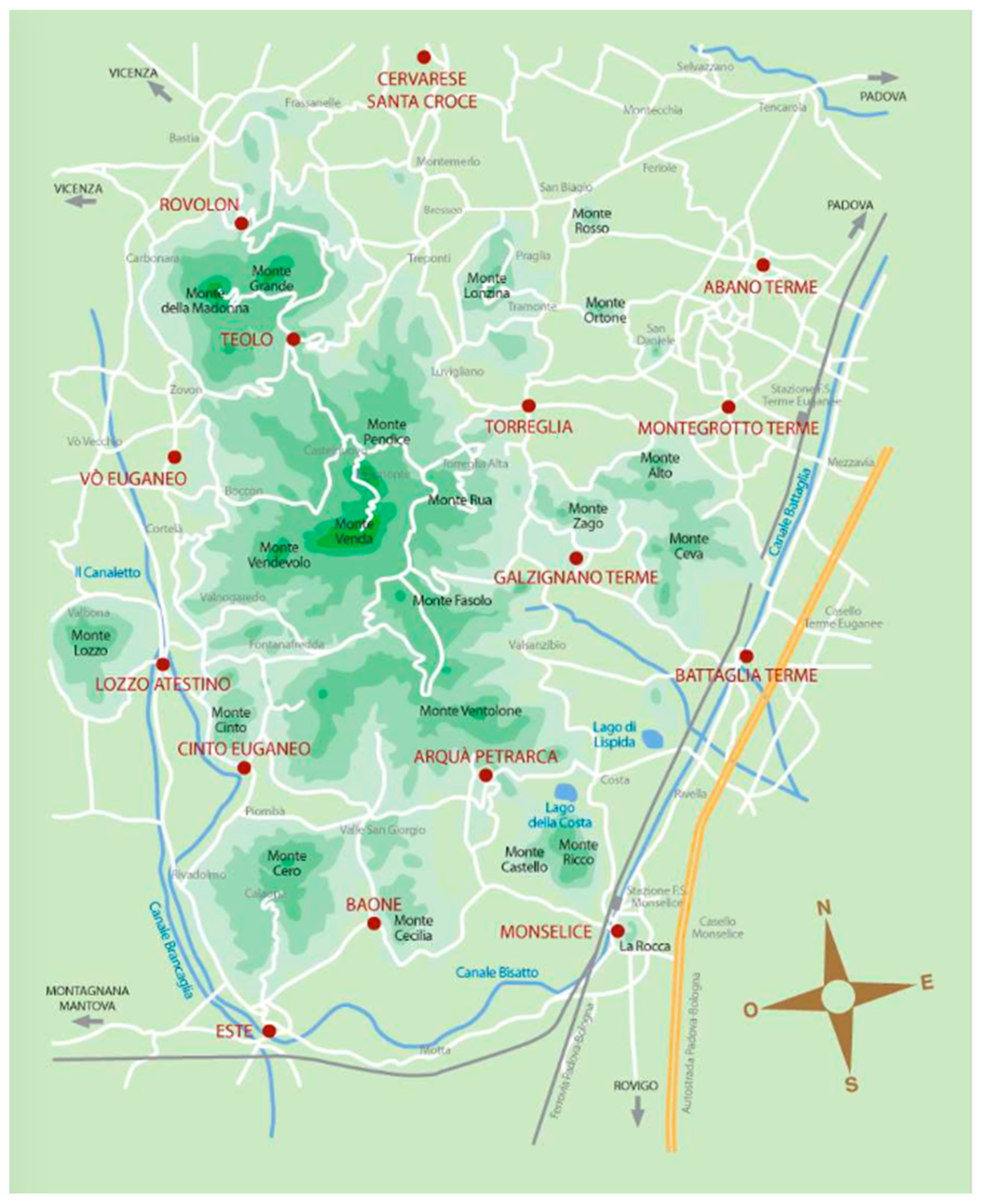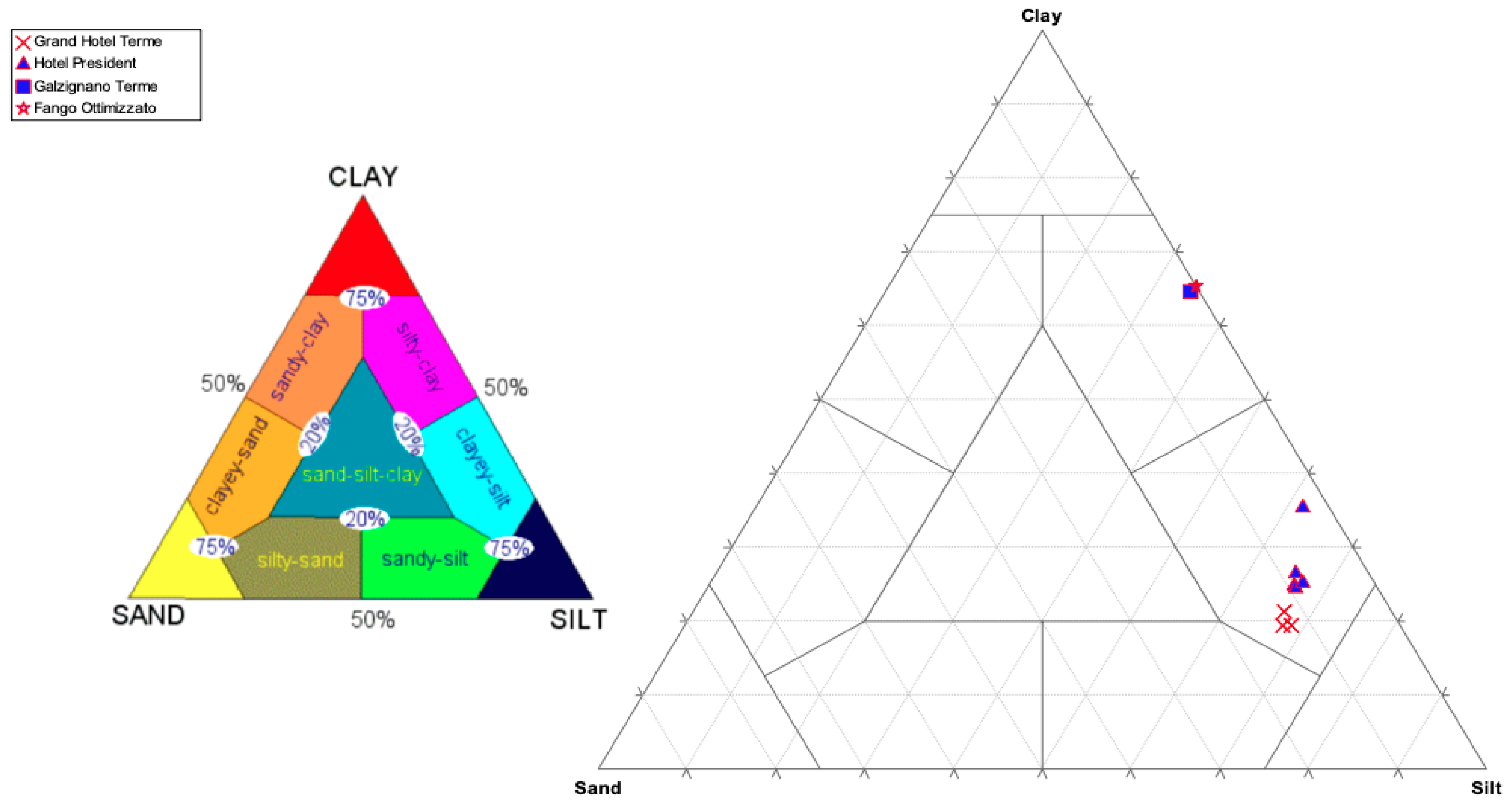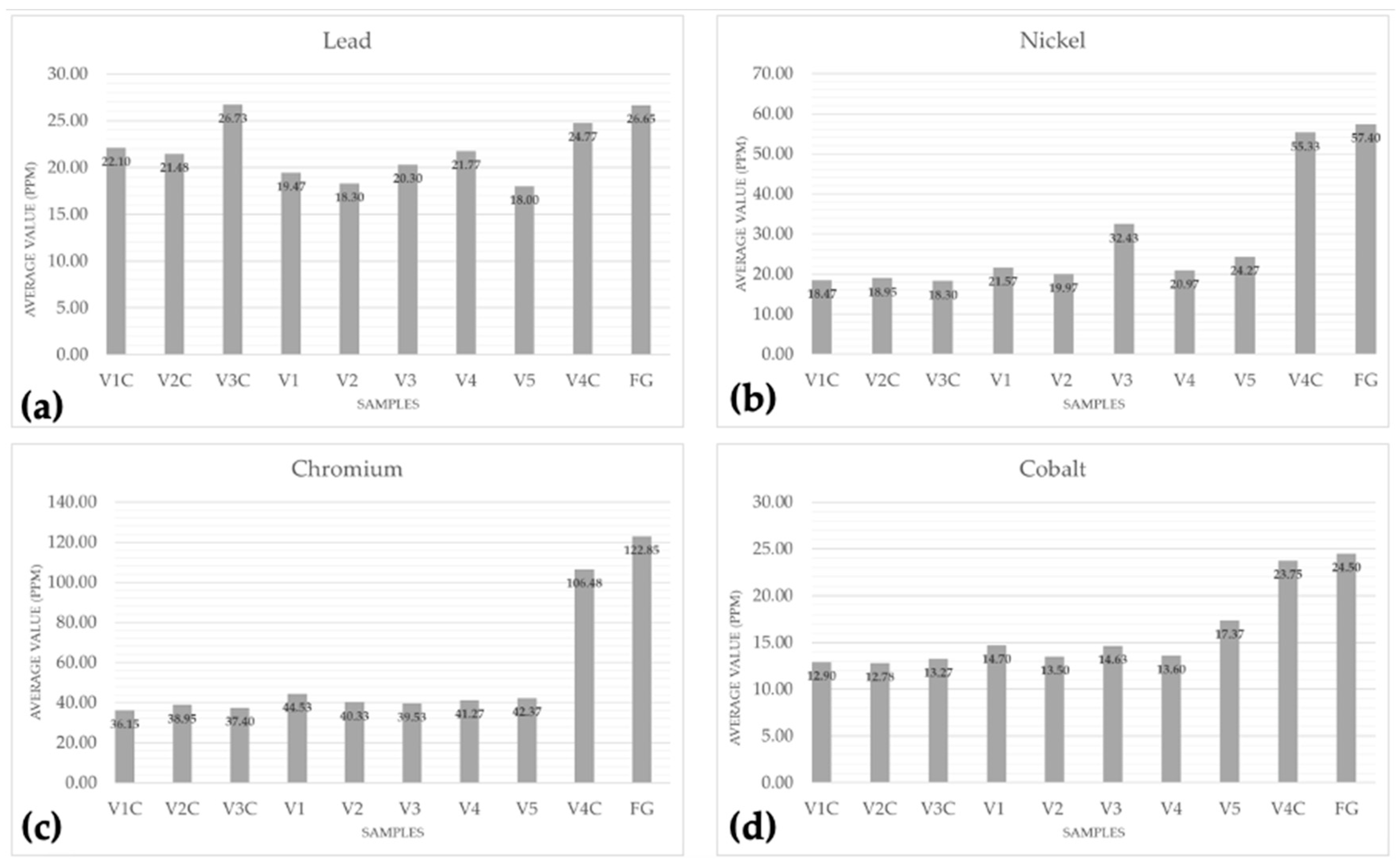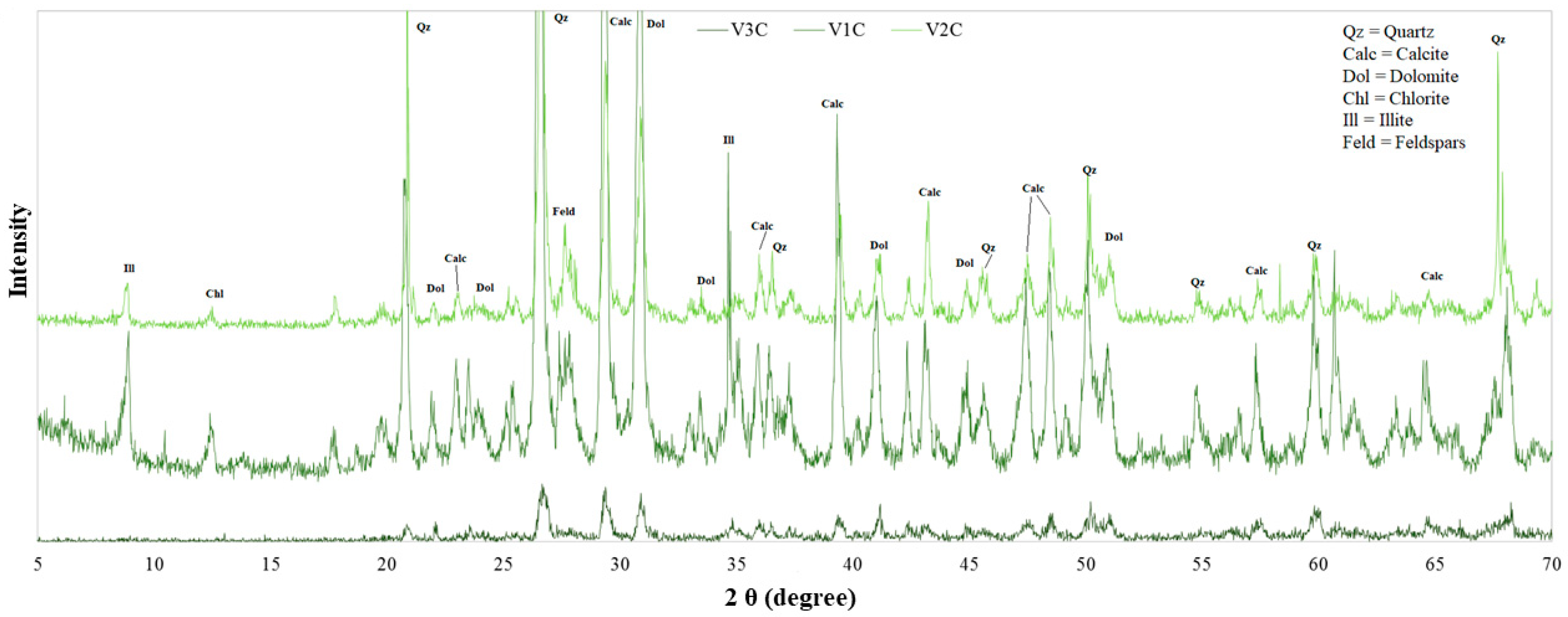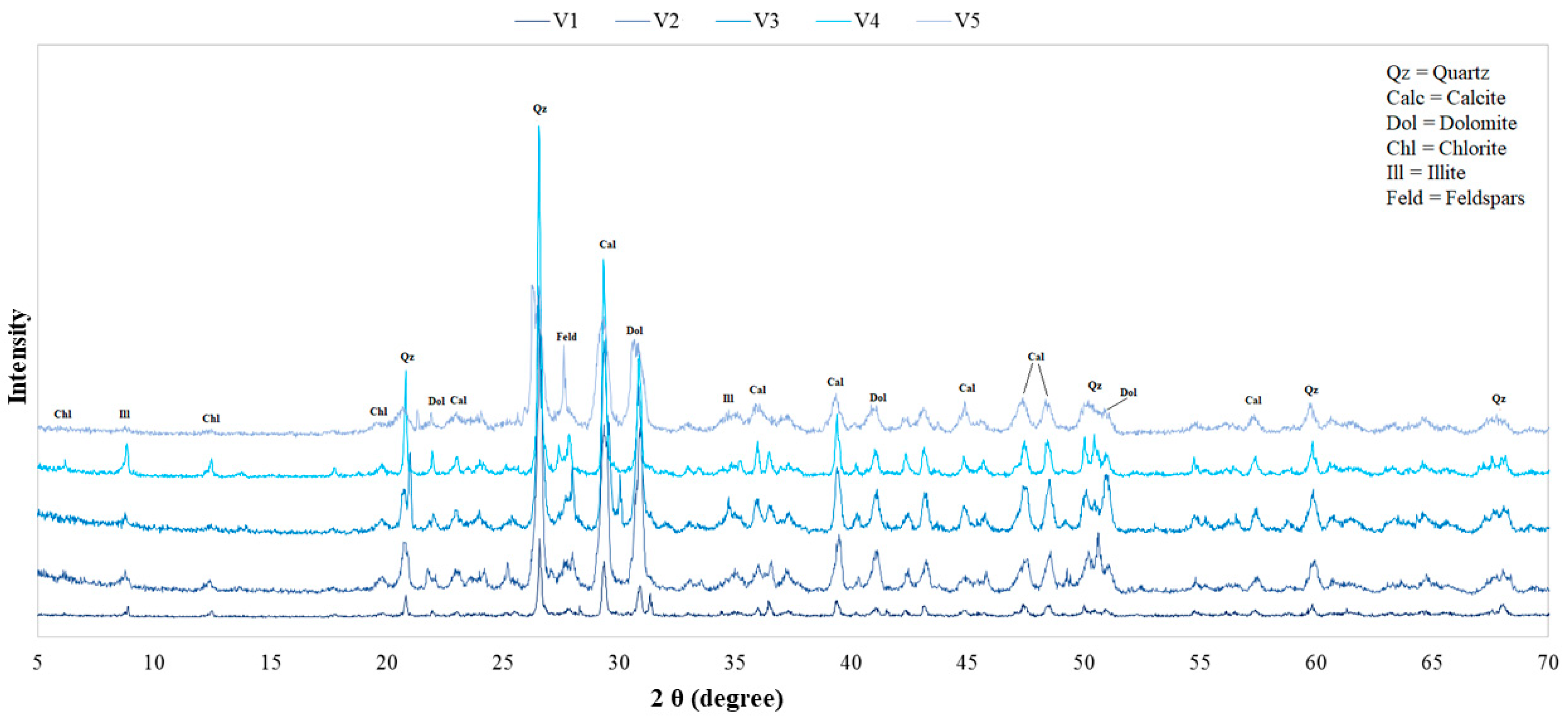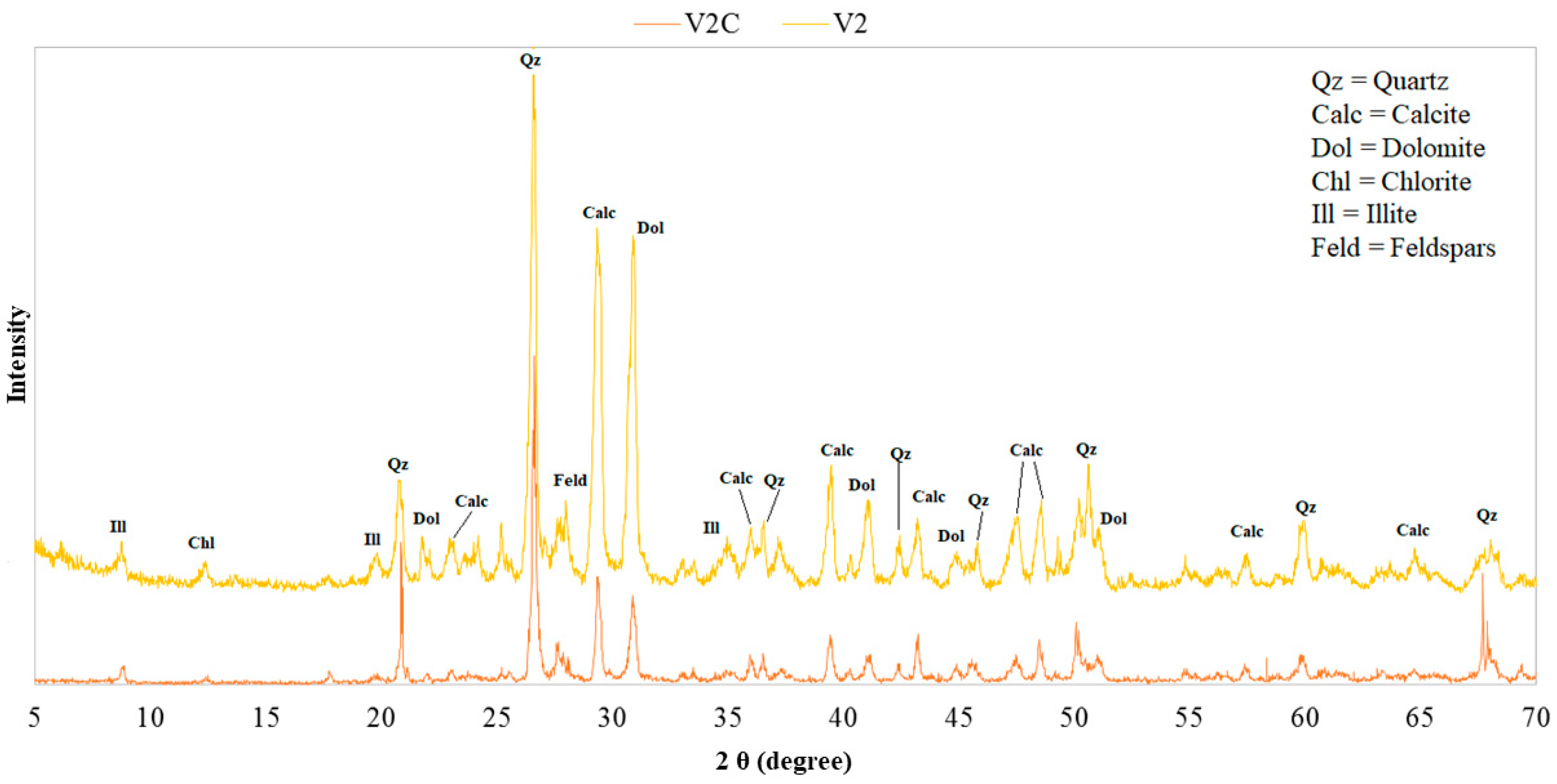3.2. Particle Size Analysis
Loose sediments and sedimentary rocks consist of discrete particles and their characteristics and classifications are based on the texture and on chemical-mineralogical composition. The sediment, from a granulometric point of view, can be classified considering a size scale, among which the most adopted is the one proposed by Wentworth [
23], according to which the clasts making up the sediment can be divided into six main classes.
The sediment is normally composed of one or more size classes and, for this reason, the size’s classification should take into account the relative abundances of each of the constituent classes. Shepard’s diagram [
24] is used for classification purposes. Important properties are directly and indirectly linked to the grain size of the sediment: Air and water permeability, plasticity (and therefore workability), water retention capacity, and nutrient availability.
Figure 2 and
Table 4 show respectively the distribution of the analyzed samples within Shepard’s triangle and their composition in percentage of sand, silt, and clay.
The grain size classes to which they belong are the following:
“Clayey-silt”: With a prevalent silty component, represented on average by 65.42% of the total sample; followed by the values of clay with an average of 24.62% and those of sand (9.83%), which constitutes the minor component of the sample.
“Silty-clay”: With a prevalent clay component, represented on average by 64.37% of the total sample; followed by silt values with an average of 34.41% and those of sand (1.24%), which is the minor component of the sample;
The samples taken from the Grand Hotel Terme and Hotel President are classified as clayey-silt, while the samples from Galzignano Terme and the optimized mud are classified as silty-clay.
The grain size analysis lends itself to several considerations, first of all the assessment of the skin feel. The ideal product should have the lowest possible sand content because, being the coarsest fraction, it could cause irritations or injuries to the skin. Moreover, a higher clay content is preferable compared to the silty component: The clay fraction determines, at the same volume, a greater specific surface area, giving the mud a greater reactivity (for example, a greater cation exchange capacity). Among all analyzed samples, from the granulometric point of view, the “optimized” sludge (FG) is the best one and can be elected as a reference product for the possible development of clay-based cosmetic products. It is classified as “silty-clay” and is composed of only 0.82% sand. In comparison with other studies reported in the literature [
25], muds collected in the B.I.O.C.E. area have a finer particle size, so it is possible to affirm that these natural muds have a better quality and are gentler when applied on the skin.
The granulometric analysis permitted an understanding of whether the maturation process influences the granulometry of the mud itself. With regard to the SPA mud collected at the “Grand Hotel Terme” (VnC series), the particle size distribution is similar for all the samples; therefore, it can be said that the increase in maturation time from 3 weeks (V3C) to 1 month (V1C series) up to 6 months (V2C series) does not significantly influence the particle size of the mud.
For the SPA sludge collected at the “Hotel President” (Vn series), it is noted that, in the same way, the maturation process does not significantly influence the grain size. The samples of the V5 tank, despite being a “clayey-silt” like the others collected at the same SPA, contain a higher percentage of clay than the other tanks. Moreover, they have a significantly lower sand content, which is assumed to be due to the inevitable sedimentation process, which allows the deposit of sand at the bottom of the pool.
About the SPA mud collected at “Galzignano Terme” (V4C), since the clay fraction represents about 60% of the total sample, the classification of “silty-clay” given by Shepard’s triangle is confirmed.
Table 5 shows, instead, the granulometric distribution (wt%) of the sandy fraction. It is noted that the greatest contribution is given by fine sand (1.72%) and very fine sand (6.11%), which represent respectively 19.28% and 68.50% of the total sand component, while the components of very coarse sand, coarse sand, and medium sand represent respectively 1.01%, 4.26%, and 7.06% of the total sand component. It can be confirmed that the presence of the sandy fraction in natural SPA mud, following its application, does not cause irritative or abrasive problems since, according to the Udden–Wentworth classification (
Table 6) [
23], the sand dimensions corresponding to the classes “fine sand” and “very fine sand” are included in the grain size range 125–63 μm. Other studies on the grain size of natural SPA mud also confirm this theory [
25].
To increase the functionality of the product, it is preferable to use, as already mentioned, clays and sludges composed mainly of clay. Depending on this, it is more preferable to use “optimized” mud, classified as “silty-clay”, than natural SPA mud samples, classified as “clayey-silt”.
3.3. Chemical Analysis by X-ray Fluorescence (XRF) and Quantification of Heavy Metals
In
Table 7, the values relative to the main oxides and those present in traces are reported, which have the following composition ranges: SiO
2 = 50.59–58.62%, TiO
2 = 0.48–0.82%, Al
2O
3 = 8.82–20.27%, Fe
2O
3 = 3.02–6.85%, MnO = 0.15–0.23%, MgO = 3.16–7.07%, CaO = 6.61–25.71%, Na
2O = 1.07–1.80%, K
2O = 2.15–2.34%, P
2O
5 = 0.11–5.72%, and LOI = 4.85–19.68%.
The samples analyzed show a positive correlation between SiO2% and Al2O3%, due to the nature of the clay composition sludge with a bimodal distribution. The SiO2% content is mainly related to the abundance of quartz due to its lack of correlation with the oxides of the other elements, as confirmed by the XRD analysis.
The group of samples with low concentrations of aluminum and silicon (natural SPA mud) are characterized by the presence of aluminum-silicates, such as clayey minerals. The second group (semi-synthetic sludge-Series Vn and “optimized sludge” -Series FG) is characterized, instead, by a high concentration of aluminum, related to higher concentrations of silicon. This suggests the presence of aluminum in other mineralogical phases, such as aluminum oxides and hydroxides, with the possibility of skin assimilation of the element itself. Furthermore, the XRF analysis confirms the classification of sludge previously made on a granulometric basis. In fact, the clay fraction, indicated by the presence of the Al2O3 percentage, is higher for V4C and FG series samples.
The natural SPA mud samples have a negative correlation between the CaO and Al2O content. The relative low concentrations in SiO2 and Al2O3, compared to the other samples, are related to the abundant presence of bioclasts, expressed by CaO %, mainly contained in carbonates (CaCO3). The LOI content, expressed as % values, confirms the high concentration of CaO in natural SPA mud, because it is correlated to the initial presence of whips and bioclasts detected in the natural samples, which are instead visually absent in the other samples.
There is a negative correlation between the MgO and SiO2 content and a higher magnesium concentration in the natural SPA sludge group. It can be assumed that these samples are richer in chlorite, amphibole, and smectite.
The positive correlation between the Rb ppm and Al2O3 content indicates the presence of clay sediments probably rich in illite. The variation between K2O, usually characterized by a geochemical behavior similar to Rb ppm, and Al2O3 contents shows that the presence of potassium is comparable between high and low aluminum content samples (V4C-FG series and natural sludge series, respectively). Generally, potassium is hosted in aluminum-silicate minerals; therefore, it can be confirmed that SPA sludge is illitic. In the group of semi-synthetics and optimized sludge, the presence of potassium is probably due to the presence of hydroxides.
There is also a positive correlation of the Fe2O3 and SiO2 content among all the samples. The presence of iron is probably due to the presence of sulphides.
The correlation between the MgO content and transition elements, such as nickel and chromium (values reported in
Table 8), allows division of the samples into two main populations: The “optimized” sludge and the V4C series samples have higher nickel and chromium contents than the natural SPA sludge group (V1C, V2C, V3C, V1, V2, V3, V4, V5 series). Generally, magnesium silicates contain nickel and chromium; instead, in this case, the negative correlation between the oxide and transition metals indicates that the enrichment of these elements is due to the presence of nickel and chromium sulphides, or to adsorption phenomena in the clay minerals.
Furthermore, the concentrations of the elements are directly proportional to the concentration of Al2O3 (positive correlation), which expresses the tendency of these elements to concentrate within the fine fraction of the sample.
Taking into account that SPA sludges may contain potentially hazardous elements [
7], the assessment of the chemical composition of the sample must take into account the assessment of the grain size profile, especially for samples classified as “clay-silty”, as the clay fraction determines, for the same volume, a greater specific surface area, giving the sludge a greater reactivity.
Consequently, if, on the one hand, this favors the exchange of macronutrients and micronutrients that are probably essential for the body [
26], on the other hand, clay particles can control the mobility and bioavailability of potentially toxic elements (As, Cd, Co, Cr, Hg, Ni, Pb, Sb, Se, Te, Tl). With regard to this latter aspect, it is important to highlight the problem related to the presence of heavy metals: These elements are naturally present in rocks, soil, and water and they can be introduced in the processing of many raw materials. The concentration of Ba of the analyzed samples could be linked to the adsorption capacity of Euganean Hills clays towards mobile elements [
27]. According to Cappuyns 2018 [
28], despite relatively high pseudo-total concentrations (224.37–445.35 ppm), as compared to commonly investigated trace elements (Cd, Zn, Pb, Cu, Ni), Ba showed low mobility. This indicates that only a very small proportion of Ba is readily available for leaching or uptake. Leaching tests and extractions, developed to evaluate heavy metal mobility in soils, require careful interpretation when Ba is considered and are likely to not always be suited for Ba because of unintended side effects, such as precipitation reactions.
The data of the XRF analysis also allow an evaluation of, among the heavy metals mentioned above, the concentrations of Pb, Ni, Cr, and Co. However, it is important to highlight that the values collected from this analysis confirm the results reported in other studies [
29], even if there is always some variability.
Since the current European Regulation (Annex II) [
30], for the substances mentioned above, does not set either the maximum acceptable concentration or the toxicity threshold, we decided to use as a reference limit value for Pb the one set by the ICCR (International Cooperation on Cosmetics Regulation) [
31] and Health Canada [
32], which corresponds to 10 ppm. In addition, we took into account that, according to the European and US Pharmacopoeia, the amounts of Pb in bentonite should not exceed 40ppm [
7]. The average values (ppm) relative to Pb of each sample were compared with these reference values in order to understand how much exceeds the concentration of the metal. In
Figure 3a, it can be observed that no sample falls within the set limit, exceeding it by 1.5 to 2.7 times. On the other hand, according to the standards of the Pharmacopoeia, the levels of Pb remain within the acceptable limits, since they are all lower than 40ppm (it must be taken into account, however, that the limits imposed by the Pharmacopoeia refer to bentonites, which are clays, not peloids, but at the same time, peloids are partly composed of clays). These latter considerations for semi-synthetic and optimized sludge are somewhat in contrast with the fact that they are considered by consumers as being better than all natural ones because many are purified.
Particular attention was also paid to nickel, as it is considered the main cause of allergic contact dermatitis (CD). However, chromium and cobalt are also highly allergenic elements.
Although there is a lack of official limits on the concentration of heavy metals in cosmetics, the reference tolerance limit is conventionally set to 1 ppm. This value has been extrapolated on the basis of several studies involving subjects with CD, which have shown that most nickel-allergic patients do not show reactivity for concentrations below 1 ppm [
33,
34]. The mean values (ppm) for nickel, chromium, and cobalt of each sample were correlated with the reference value (
Figure 3b–d): All samples, for all elements, were well above the threshold value of 1 ppm. In addition, it can be observed from the histograms that, for the three elements taken into consideration, the samples with the highest concentrations are the semi-synthetic sludge (V4C) and the optimized sludge (FG). As reported above, this an important issue that should be taken into account.
On the other hand, it is reasonable to think that the concentration of heavy metals varies according to the extraction basin. Indeed, in studies on muds extracted from other basins, the concentration for each metal is largely variable, ranging from similar to totally different values [
25].
3.4. Mineralogical Characterization by X-ray Diffractometry (XRD)
X-ray diffractometry allows a qualitative and semi-quantitative evaluation of the different mineralogical phases present in the sample. This analytical technique is based on the properties of each crystal substance (reticular plans) to diffract the X-ray products by Coolidge vacuum tubes [
35].
The mineralogical analysis allows the identification and comparison of the composition of each sample and the influence of the maturation process on the mineralogical composition.
Most samples show a simple mineralogical association, with a few exceptions. Quartz, calcite, and feldspar are always present, and dolomite is common, as well as phyllosilicates (chlorite and illite). In the “optimized” mud samples, kaolinite is also present.
To understand if the maturation process influences the mineralogy of the SPA mud, the X-ray diffraction patterns of the samples were superimposed in correspondence with the different maturation times:
Figure 4 and
Figure 5 show, respectively, the mineralogical compositions of the “Grand Hotel Terme” and “Hotel President” samples. The overall maturation process does not imply a significant change in the mineralogical composition, as also confirmed by other studies carried out in different SPAs [
15,
36].
The mineralogical composition was also compared between sludge at the same time of maturation (V2C, V2), taken from two different hotels (“Grand Hotel Terme” and “Hotel President”), which have two separate wells. As shown in
Figure 6, there is no significant change in composition, confirming an expected fact: The geological characteristics of the territory do not change in such a circumscribed area as the Euganean SPA basin.
The “optimized” mud was formulated as a possible product for domestic use, also in view of maintaining a low concentration in heavy metals; therefore, the relative diffractogram was compared with that of a natural SPA mud, because the “optimized” product was realized using as a model mud the one from Euganean SPA basin for its known curative properties. In
Figure 7, it can be seen that the “optimized” mud lacks minerals, such as chlorite, compared to natural SPA mud, but presents kaolinite, used in the formulation phase for its anti-caking function. In the formulation of the “optimized” mud, a small amount of bentonite has also been included, as can be seen by its small peaks between 5 and 6 2θ values [
37,
38].
3.5. List of Physical, Chemical, and Microbiological Analysis
In order to better understand the analysis pattern followed by us, it is useful to summarize the investigations that should be carried out on SPAs matrices, to characterize them from several points of view and identify a possible characteristic fingerprint.
From a physical point of view, it is essential to characterize the mud according to the particle size of grains. As mentioned in the introduction, the sludge is applied on the external surface of the body, typically with an initial coating phase. The particle size is a quality index, because too high grain sizes could trigger irritation on the skin. Mineralogical characterization is another fundamental analysis, with the sludge being a mixture of different minerals. Understanding the mineralogical composition of a natural mud could be the starting point for formulating a cosmetic product for domestic use, which maintains the same characteristics as the SPA treatment or at least would consent the benefits achieved by the SPA treatment.
From a chemical point of view, matrices should be characterized at first by the pH, always taking into consideration the application on the external surface of the body: The skin has a good buffering capacity, but a too alkaline pH damages its barrier properties. Furthermore, because the different matrices differ from one another in the chemical composition, according to the sampling area, this can be useful to verify both the quality and authenticity.
The microbiological aspect was not considered in this first part of the study but remains an important aspect currently under investigation in our laboratories. In fact, the muds from the Euganean SPAs (Abano, Montegrotto, and Battaglia Terme) are characterized by the presence of autotrophic, mixotrophic, and heterotrophic microorganisms. It is known that SPA mud is widely used in European countries for the treatment of rheumatic diseases and its therapeutic effect is ascribed to molecules deriving from microrganism metabolism, which are released during the maturation process [
39].
Understanding the nature of the biological matrix is important to associate the therapeutic effect with a precise mud. Since each SPA boasts the ability to treat aspects of even very different pathologies, the characterization of the physical-chemical composition and of the microbiome would be a very useful cross-method for the study of the relationship between the composition and effectiveness of the mud itself. For this reason, characterizing the matrix also from a microbiological point of view is fundamental to understanding its possible therapeutic effects.
